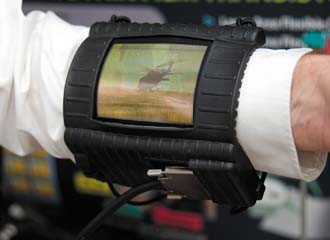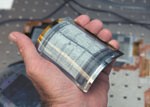Malleable Materials Move Closer To Readiness
 |
The U.S. Army moved closer to deploying flexible display technology to the battlefield after field tests of the capability during the Command, Control, Communications, Computers, Intelligence, Surveillance and Reconnaissance On the Move exercise last year. Flexible displays offer several advantages to warfighters, including less fragility than traditional screens. |
The U.S. Army took the next big step toward deploying flexible displays to soldiers on the battlefield by evaluating prototypes of a wrist-mounted form of the technology during a recent field exercise. Users accessed video feeds and information about firing on targets during the trials of the displays, marking a major shift in the progress of developing this type of tool.
Research on flexible displays has been ongoing for many years at various institutions, including the Army’s Communications-Electronics Research, Development and Engineering Center (CERDEC). Center personnel and other Army officials believe that flexible displays will apply to many systems on the future battlefield. For the most current advancement, CERDEC had a Small Business Innovation Research Phase 3 contract with Universal Display Corporation, which supplied the eight prototype wrist-mounted technologies for assessment.
The company delivered four of the flexible displays to CERDEC and four more to Program Executive Office Command Control Communications-Tactical’s (PEO C3T’s) Product Director-Common Hardware Systems (PD-CHS). Soldiers from the latter evaluated the inventions at CERDEC’s annual Command, Control, Communications, Computers, Intelligence, Surveillance and Reconnaissance On the Move (C4ISR OTM) exercise in 2010. Testers successfully accessed video feeds from unmanned aerial vehicles (UAVs) and obtained fire support data. Ray Schulze, chief, CERDEC Command and Control Directorate (C2D) Information Management Branch, explains that access to video imagery via a wrist-mounted device is “a significant accomplishment that we’ve been striving for for many years.”
The successes during the exercise marked a new achievement for the Army. “It was the first time high-resolution [134 lines per inch] full-color flexible displays were used to demonstrate Army tactical data and video imagery at an OTM event,” Schulze states. In the 2008 exercise, under C2D-managed funding from Congress, Aveso Incorporated demonstrated the ability for soldiers to view instant messages from Force XXI Battle Command Brigade and Below. That technology has monochrome, 24-character, alphanumeric, sunlight-readable electrochromic displays.
The flexible devices used in the 2010 exercise contain phosphorescent organic light-emitting diode (OLED) displays built on thin, flexible metal foil substrate that has been conformed into a slightly bent shape to fit into a housing structure that can be worn on the wrist. The screens are a little bigger than 4 inches with a quarter video graphics array full-color, full-motion active-matrix OLED display that has amorphous-silicon thin-film transistor backplanes. LG Display fabricated these onto the thin metallic foil, and the front planes were built on top by Universal Display Corporation. Design and integration was performed by L-3 Display Systems. The display offers 480 pixel x 320 pixel resolution, similar to most personal digital assistants.
During the field exercise, soldiers obtained the video from the UAV feed via a video-interface device. This tool streamed the moving images and converted them into information the display could present to wearers. Troops accessed fire-support data via a belt-worn computer with the appropriate software installed. The computer was tethered to the display device with a hard-wire cable. Schulze says that one path forward is to eliminate the cable and transmit information wirelessly. He describes an idea to swap out the LCD display on a smartphone for some type of flexible display because the cell phone can access information without cables and store information. “That’s the direction we’re heading,” he states. Schulze says that in addition to smartphone-type flexible display devices, the Army also has interest in sewing displays into the arms of uniforms to allow rapid access to information.
While in its current form the technology is conformable, in the future developers believe it will be completely malleable, able to roll up and fit into pockets like paper maps. Janice Mahon, the vice president of technology commercialization at Universal Display Corporation, and general manager, UniversalPHOLED Material Sales Business, explains that her company started out with an idea to create a pen-like device that troops could carry in their uniforms then pull out and unroll when they needed to access data.
Development on that pen project continues, and the delivered wrist-mounted prototypes are part of the progression toward such maneuverable technology. Similar concepts could offer benefits to pilots who could mount flexible technology on their knees in the same way they do paper maps today. Universal Display Corporation has a separate project with the U.S. Air Force that is examining the use of these types of capabilities.
Despite the drive toward flexible pocket-sized technology, Schulze explains that the Army is very interested in wrist-mounted technology. This form enables warfighters to access data quickly and easily while keeping their hands free for other tasks such as manipulating their firearms. Flexible technology also offers several other advantages.
 |
Developers are working to develop various types of flexible displays including organic light-emitting diode (OLED) and electrophoretic types. The latter already is available commercially in electronic book readers. Though electrophoretic options are closer to military fielding, OLED offers more capabilities such as full-color displays and video support. |
Schulze also touts another advantage the flexible-technology research offers the United States: developers are carrying out the work in-country, not overseas. However, officials say that whether or not that will be the case when production time comes is unknown.
Reaching the current state of technology is the result of strong partnerships not only among industry, government and academia, but also within the Army itself. In addition to CERDEC’s research and PD-CHS soldier assessments, which provide necessary feedback to system developers, the Army Research Laboratory (ARL) plays a large role in the story of flexible-display technology. “ARL is our technical liaison on these contracts,” Schulze says. The center loaned its OLED devices to the laboratory and the PD-CHS for demonstration purposes.
The ARL is a partner in the Flexible Display Center at Arizona State University. Dr. Eric Forsythe, team leader for ARL’s Display Technology Team and deputy program manager at the Flexible Display Center, says that his organization’s role in flexible technology research for the Army is not only to leverage programs and focus key challenges to enable the capability, but also to examine how to manufacture the devices at high-enough volume at low-enough cost to make fielding feasible. Manufacturing flexible displays is difficult and a major hurdle to the deployment of the technology. It also is one reason the capability is not readily available on the commercial market.
Forsythe explains that in addition to military and academia, the Flexible Display Center includes a consortium of 30 industry partners, some of which develop technology, while others focus on manufacturing or integration with current Army systems. “It’s not good enough to demonstrate ‘gee whiz’ in a laboratory and have no way to manufacture it in a reasonable manner,” Forsythe states.
Universal Display Corporation is one of the companies in the consortium and has been working on flexible foil technology for a decade. It received its first grant to study the concept from the Defense Advanced Research Projects Agency in 2000 and since has received other government funding as well as invested internal research and development dollars. In addition to the experimentation being carried out with metal, Universal Display Corporation and other organizations also are researching plastic options. For example, the Flexible Display Center has a project with DuPont Teijin Films that uses plastic substrates.
Another flexible-display option that both the military and commercial sectors are pursuing is electrophoretic technology. Researchers have demonstrated this on a flexible substrate for about a year, and it is more commonly used in devices such as the Sony e-Reader or Amazon Kindle. The technology is more advanced than OLED in terms of being ready for use, but it offers less capability. For example, it does not support video or full-color displays.
For the Army, according to Forsythe, electrophoretic technology is closer to the manufacturing stage than OLED. While the two technologies are separate, he explains that they both are leading the way toward full-scale production. “We don’t see those as competitive,” he says. “They’re complementary.”
The ARL also is examining the integration of flexible displays with several system platforms. Forsythe explains that a critical piece of the laboratory’s research is connecting the flexible display technology with the right applications to provide utility and value to the warfighter. He re-emphasizes that it also is crucial to ensure that the industry base is prepared for large-scale production when the Army needs to purchase devices in greater volume.
Work to progress the technology is happening in several ways. In addition to the user assessments carried out by soldiers in PD-CHS, the ARL also has agreements with the Army’s Armament Research, Development and Engineering Center (ARDEC) at Picatinny Arsenal and the U.S. Army Tank-Automotive Command ARDEC for input from those sources. With the latter, developers discuss how to ensure the ultimate solutions guide and control automotive assets.
Forsythe explains that partnership is critical during each phase of development, from understanding industry’s ideas all the way to applications for the Army. This way, the service branch ensures that the technology provides novel applications for soldiers to bring information to the edge.
User feedback also ensures appropriate future configuration. At this point, the assessment information helps developers move the technology in the Army decision process. Forsythe estimates that the next two to three years will be critical for the research, wrapping up the science and technology development. At that point, mature models will be evaluated, and decisions about fielding will begin. What systems will integrate with the displays remains an evolving question, but integration experts keep abreast of the latest system developments in the Army to ensure that the displays will operate with necessary network backbones.
WEB RESOURCES
ASU Flexible Display Center: http://flexdisplay.asu.edu
CERDEC Command and Control Directorate: www.cerdec.army.mil/directorates/c2d.asp
Army Research Laboratory: www.arl.army.mil
Universal Display Corporation: www.universaldisplay.com




Comments